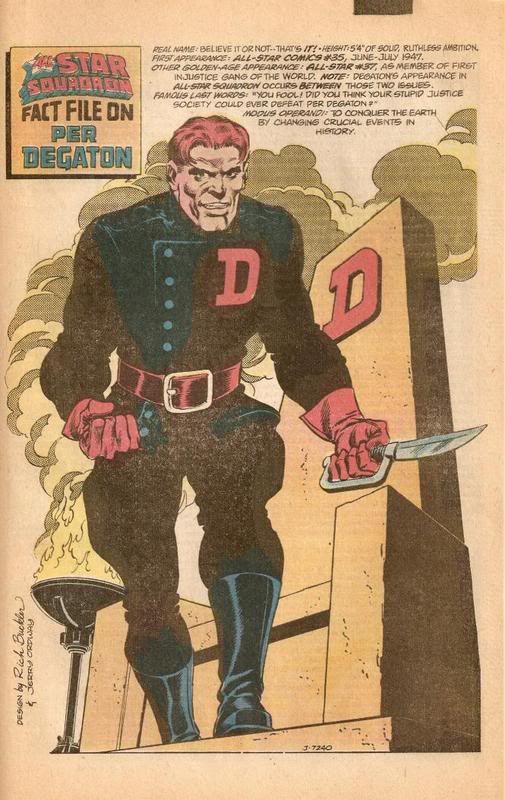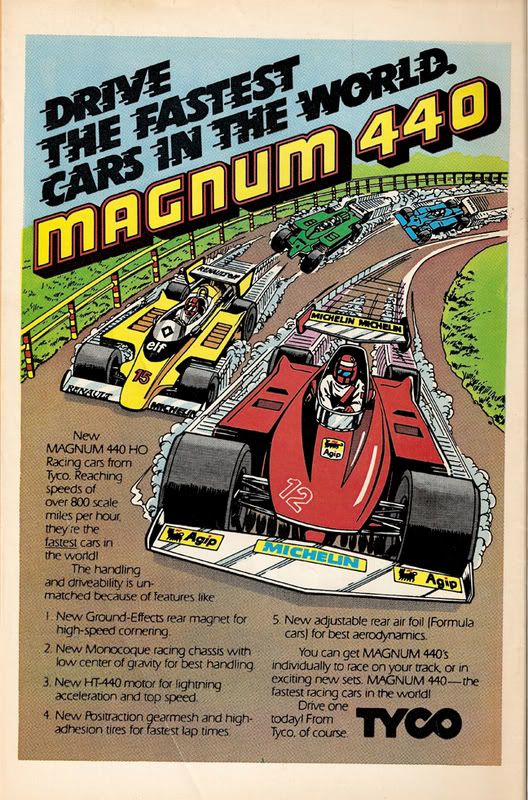 Cover Date: October 1981
Cover Date: October 1981Cover Price: $0.50
Release Date: July 23, 1981
Story Title: “The Tyrant Out of Time!” -26 Pages
Cover: Joe Kubert
Writer: Roy Thomas (Co-Creator)
Penicller: Rich Buckler (Co-Creator)
Inker/Embellisher: Jerry Ordway
Colorist: Carl Gafford
Letterer: John Costanza
Editor: Len Wein
Heroes: Atom I, Doctor Mid-Nite I, Hawkman I, Johnny Quick I, Liberty Belle I, Phantom Lady I, Plastic Man (Earth-2), Robotman I, Shining Knight I
Villains: Per Degaton, Professor Zodiak, Sky Pirate, Solomon Grundy, Wotan
Supporting Characters: Danette Reilly, Dr. Everson, Dr. Zee, Senator Henry Knight, Unnamed Reporters, Unnamed Gangsters
Memorable Quote: “That means—before long, they may seek me out! Well, if they do, they’ll have no help from the Justice Society—BECAUSE THEY’LL ALL BE DEAD!”- Per Degaton
Synopsis
The new All-Star Squadron rush out of the White House headed for their first mission stopping only to talk to a few members of the press camped outside and to capture a gang of thugs that knocked over an armored car. Soon afterward the group is riding in an unarmed bomber with Hawkman in the pilot’s seat. With time on their hands the heroes reveal their secret identities and origins to each other. Their stories and concern over the fates of missing members of the Justice Society is interrupted by air chatter describing enemy aircraft approaching San Francisco.
Meanwhile Degaton’s craft surfaces and takes in some fresh air before returning to his prisoners, the Shining Knight and Danette Reilly. Sir Justin demands to know why Degaton is attacking the coast. Degaton decides to tell his tale, though he warns that even with his own time travel experiences Sir Justin may have trouble believing him. He relates to his captives a tale of the Justice Society and their battle with Axis spies who were attempting to abduct a gathering of America’s most brilliant scientists who were developing a bomb defense formula. Such a formula existed in the future and since the scientists were too frail the JSA travel to the future to secure it for them. Despite a successful first test of the formula Degaton, who had been acting as an assistant to one of the scientists, sabotaged the effort in a jealous rage and after a second failure the formula was discarded.
Degaton had stayed on as an assistant to Professor Zee and in 1947 the scientist continued with his experiments in time travel. Degaton shot Zee and attempted to use the device to conquer the world but was defeated by the Justice Society. Fortunately everyone, including Degaton, forgot about the incident after the timeline had been corrected. After a time Degaton realized that the bizarre dreams about conquering the world he had been having were real. This time Degaton killed Zee and used his machine to travel further into the future where he realized that with all of the technological advances a man would be a fool to try and take over the world after the end of World War Two. Degaton came up with a number of scenarios, but each time he saw the flaws they had and decided against them. Finally the time storm that had clouded the era between September 1939 and December 6, 1941 passed and Degaton realized that he could change history by tricking the Americans into concentrating on Japan instead of Germany and leaving the Americans and the Japanese fighting in one stalemate and Russia and England fighting Germany and Italy fighting another. To keep the Justice Society busy Degaton gathered some of the JSA’s future enemies to defeat them. After Degaton finishes his story Danette accidentally brushes up against Sir Justin’s sword, which frees her from Wotan’s mystical shackles. She quickly does the same to Sir Justin who reclaims his sword just in time to take on Solomon Grundy.
Meanwhile Sky Pirate leads the squadron of hypnotized Japanese pilots in an attack on San Francisco. On the ground Sandra Knight changes into her identity of Phantom Lady while Hawkman, Robotman and Johnny Quick take care of the pilots in the air. From the Sub-Sea Carrier Degaton watches Hawkman defeat his pilots and is incensed at the interference. Realizing they will soon seek him out Degaton realizes that he has to enact desperate measures and presses the button marked Volcanic Isle Detonator.
Notes
- At the beginning of this issue the reporters posted outside of the White House break into the Star Spangled Banner after the All-Star Squadron leaves. This was based on fact.
- The aircraft the All-Stars are flying in was a B-29 bomber. As a reader named Andy Glaess pointed out in a letter printed in All-Star Squadron #6 that particular aircraft didn’t go into service until 1944. Roy Thomas responded that the mistake was noticed but there wasn’t time to fix the error.
- The All-Stars revealed their origins to each other during the plane ride to San Francisco, though none of them had flowers in their hair. This was a rather neat little storytelling device and Roy Thomas’ ability to write the back of the trading card versions of who these characters were and how they came to be was rather impressive, as was Buckler and Ordway’s art on these pages.
- Liberty Belle didn’t wear a mask in her Golden-Age appearances. She let her Veronica Lake hair style hide her face.
- Sandman I, Starman I, Dr. Fate I, Johnny Thunder and Thunderbolt and the Spectre I all appear in flashbacks in this issue, much like they did in the last one. Ten will get you one that when we see them next issue they’ll be glowing and unconscious. Then again I’ve read that issue, so I guess I’m cheating.
- The Hostess Ad this month related the amazing adventure of Batman versus the Crime Director. I wonder why this guy didn’t make it as one of the major bad guys in Batman’s rogue’s gallery. Maybe it was the fact that he was brought down with the assistance of Hostess Cup Cakes.

- One of the rules I have developed for this site (and by developed I mean I made it up right now) is that I will not, under any circumstances make fun of any plot elements from the Golden Age that Roy Thomas brings into the stories either through the actual plot or flashbacks. The stories are what they are, it was a different age and it is unfair to judge those stories from a modern standpoint. This is why you won’t read any pithy comments regarding the concept of a bomb defense formula.
- This issue had two text page pieces, the first of which was a one page Fact File on Per Degaton. His height is given as 5’4” despite the fact that he appeared taller in issue one. In All-Star Comics #35 (June-July 1947)) Degaton was clearly modeled in part on Napoleon. Here’s the page:

- The second text page had this piece by Roy Thomas.
The Secret Wartime History of the Justice Society of America
Welcome to the Orientation Lecture, courtesy of editor Len Wein, artists Rich Buckler and Jerry Ordway, and myself—Roy Thomas, writer/creator of the series.
In issue #1, we promised that this time around, we’d tell you Everything You Always Wanted To Know About The World War Two History Of The Justice Society But Were Afraid To Ask. We’re here to fulfill that promise. And if we leave out anything else you want to know, be sure to let us know, okay?
The Justice Society came into existence on Earth-Two (an earth which is virtually a duplicate of our own and of the Earth-One inhabited by the Justice League of America – occupying the same space but vibrating at a different speed and thus occupying a different dimension) in 1940, as a result of events told in an important DC comics of a few years back, THE UNTOLD ORIGIN OF THE JUSTICE SOCIETY.
Its original membership roster included Hawkman, the Atom, Hourman, Sandman, the Spectre, Dr. Fate, Green Lantern, and the Flash—with Superman and Batman as honorary members. Soon afterward, Green Lantern and the Flash likewise became honorary members, being replaced by Johnny Thunder and Dr. Mid-Nite, while the Starman replaced Hourman, who took a still-unexplained “leave of absence.”
The JSA was founded partly through the efforts of Franklin Delano Roosevelt, President of the U.S. from 1933 to his death in 1945. Soon afterward, it coordinated early anti-spy activities with FBI Director J. Edgar Hoover. The JSA fought sabotage in the days of 1940 and 1941, before war was officially declared between America and the Axis powers (Nazi Germany, Fascist Italy, and military-dominated Japan.)
At one time or another, the Justice Society raised million of dollars to help war orphans (ALL-STAR COMICS #7, 1941), battled Axis influence in Latin America (ALL-STAR #9), and protected America’s foremost scientists from capture or assassination (ALL-STAR #10, as recounted last issue). These events, like all events in comics, happened months before they were chronicled and published in the pages of 1940-1941 comic-books in our world.
Then, on the morning of December 7, 1941, Japan’s military rulers attacked U.S. air and naval installations at their bases at Pearl Harbor, Hawaii. On Monday, Dec, 8, President Roosevelt asked for and got a Congressional declaration of war to avenge the “day of infamy.”
A couple of days later, Hitler’s Germany and Mussolini’s Italy likewise declared war on the U.S., and the war which had already been raging between the Axis powers and the nations of the British Empire and the Soviet Union became World War Two.
As recounted in the first issue of ALL-STAR COMICS (#11) which was written after Pearl Harbor, the Justice Society disbanded shortly afterward. Every one of its nine regular members (except the Spectre, who was, after all, a ghost) enlisted in one branch or another of America’s armed services intending to serve their country as common soldiers, airmen and sailors. There were no thoughts of personal glory, only of preserving western democracy against the fascist threat.
Alas for their intentions, as revealed in ALL-STAR #11, published in early 1942, it was simply impossible for such heroes as the JSA to remain incognito in uniform, as opposed to costumes. One after another of them abandoned the khaki to assist America’s burgeoning but desperate armed forces. The events of ALL-STAR #11 spanned a period which, at a conservative estimate, covered the first several weeks after December 7, 1941—but by the end of the issue, America’s military leaders had seen the folly of allowing the JSA to fight individually against the enemy hordes.
Accordingly, the JSA members were gathered and asked to form a new and special group, which was to be called “The Justice Battalion,” for the duration of the war. It was to operate under direct orders from the War Department, as the Defense Department of the day was called.
The JSAers, being patriots first and heroes second, agreed—and their military careers, as such, were largely ended. Though they battled the Axis forces abroad from time to time, even storming Hitler’s “Fortress Europa” more than once, they did most of their fighting from that day forward on the American Home Front, against both Axis spies and the greed-crazed criminals who tried to benefit from the carnage of war. The last reference to the Justice Battalion as such appeared in ALL-STAR COMICS #16, published at the beginning of 1943.
The comic-book, ALL-STAR SQUADRON, was created to tell the story which the wartime ALL-STAR COMICS did not, could not tell.
These first few issues, for instance, relate events which occurred between those related in ALL-STAR #10, in which the JSA went into the far-flung future to bring back a Bomb Defense Formula, as related this issues—and the happenings related from ALL-STAR #11 forward, when the JSA temporarily disbanded and its members spent weeks if not months in the Army, the Navy, and the Army Air Corps (which was not yet a separate branch of the service in those long-ago days).
Nothing in this or future issues of ALL-STAR SQUADRON is meant to negate major events chronicled in the DC comics of the 1940’s or since. If minor inconsistencies pop up occasionally—and they inevitably will—the pop-art historians of the future may rest assured that they’ll be dealt with, sooner or later. Al things come to him who waits, and judges not.
What really matter to us, though, is the sheet enjoyment and excitement with which we hope to relate these adventures of a special group—the ALL-STAR SQUADRON—whose very existence has gone unheralded until today. “Now it can be told,” as the spy memoirs used to say.
Nothing could be more likely, given his temperament, than that President FDR would have attempted to marshal the potential power of all of America’s super-heroes by asking them all to join one greater group, responsible only to himself.
Thus, during this trilogy of stories which is complete next issue (and whose “prologue” appeared as a special insert in JUSTICE LEAGUE #193) we witness the birth of a super-group which is not the Justice Society, but which includes it…as well as the famous Seven Soldiers of Victory (the Shining Knight and company) and a host of heroes and heroines who never belonged to any other formal group.
And so, the ALL-STAR SQUADRON is born—forged in the fires of the Second World War!
One last batch of footnotes to fantasy, as promised on page 7 of this issue—a list of the FIRST APPEARENCES of the costumed stalwarts who appear in this trilogy-plus prologue, along with a listing of their SEPARATE ORIGINS, if any—and we thank JSA-ultra-fan Jerry Bails for help in this area:
Hawkman, the Flash, Johnny Thunder: FLASH COMICS #1, published for Jan. 1940.
Dr. Mid-Nite: ALL-AMERICAN COMICS #25, April 1941.
Robotman: STAR-SPANGLED COMICS #7, for April 1942 (but recounting events which happened earlier, of course).
Liberty Belle: BOY COMMANDOS #1, for Winter 1943.
Atom: ALL-AMERICAN COMICS #19, Oct. 1940.
Johnny Quick: MORE FUN COMICS #71, Sept. 1941.
Plastic Man, Phantom Lady: POLICE COMICS #1, August 1941 (no origin for the lady, alas).
The Shining Knight: ADVENTURE COMICS #66, Sept. 1941.
Superman: ACTION COMICS #1, June 1938.
Batman and Robin: DETECTIVE COMICS #27, May 1939, and DETECTIVE #38, April 1940, respectively.
Wonder Woman: ALL-STAR COMICS #8, Dec. 1941.
Green Lantern: ALL-AMERICAN COMICS #16, July 1940.
Starman: ADVENTURE #61 (no origin).
Sandman: ADVENTURE #40 (no origin).
The Spectre: MORE FUN COMICS #52, Feb. 1940.
Dr. Fate: MORE FUN #55, May, 1940, with origin in #67.
Wildcat: SENSATION COMICS #1 for Jan. 1942.
-The back cover of this month’s issue featured an ad for Tyco’s Magnum 440, a racing car that could reach speeds of 800 scale miles per hour and had a number of other features that made this the racing car to have in 1981.


No comments:
Post a Comment